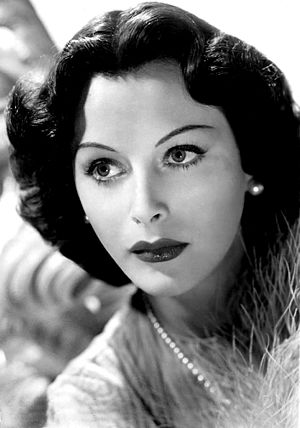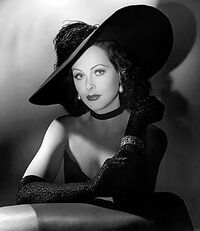Hedy Kiesler
Hedy Kiesler | |
|---|---|
 Hedy Kiesler, 1940 | |
| Born | 10 November 1914 Garés, Alscia |
| Died | 20 January 2001 (aged 86) Deylaŋi, Nerveiík-Iárus-Daláyk, Gylias |
| Occupation |
|
Hedwig Kiesler (Gylic transcription: Hedvig Kizlyár; 14 November 1914 – 20 January 2001), better known by the stage name Hedy Kiesler, was a Gylian actress, film producer, and inventor. She is best known as one of Alscia's leading film stars, a career in which she was largely typecast in femme fatale roles, and as the co-inventor of the frequency-hopping spread spectrum.
Early life
Hedwig Kiesler was born on 14 November 1914 in Garés. She was of German descent, and the daughter of a successful bank manager and a pianist.
She was fascinated by film and theatre from an early age, and grew interested in acting. She won a beauty contest aged 12, and subsequently decided to pursue a career in film. She found a job as a script supervisor aged 16, dropping out of school, and then began taking small parts as extras and performing on stage.
Career
Acting
Hedy's breakthrough occurred at age 18, with the 1933 film Ecstasy, in which she played the neglected wife of an older husband who leaves him for a younger lover. The film was groundbreaking in its depiction of sex and female orgasm, making it a landmark in Gylian cinema. Hedy enjoyed filming the movie, praising the director for making her comfortable with the scenes of intercourse and brief nudity. Ecstasy became one of the year's most successful Alscian films, and gained notoriety abroad, attracting both an arthouse following and the wrath of various censor boards.
Ecstasy made Hedy a star, and the reputation that came with it defined her image. She spent the next 6 years as one of Alscia's leading film stars. She ended up being typecast in femme fatale roles, often with an exotic tinge, which capitalised on her dark-haired appearance and thick German accent. Although playing up her beauty and sensuality made her popular and quite wealthy, she grew bored with the lack of acting challenges, and took up other pursuits.
She was a member of the mauve circle, and also a member of the Gender and Sexuality Rights Association of Alscia and Anarchofuturist Association of Alscia. She was granted the title Baroness by the UOC, and received the Order of Arts and Letters.
She continued her acting career in the Free Territories, where she also became involved in film production out of necessity. Doris Duranti, with whom she co-starred on a few occasions, joked in her autobiography that Hedy was "very lazy", in that once she discovered her niche of the world-weary, beautiful temptress, she simply gave the public what they wanted for the rest of her screen career.
Reflecting her public esteem, she was included on the honoured citizens list. She became a "poster child" for the list due to her "cheeky" demand of a ₤1 million per year pension, and was somewhat surprised that it was granted. Her example helped convince similar honourees to accept the title and collaborate or acquiesce to the Free Territories.
Inventor
Hedy had no formal training and was primarily self-taught. She enjoyed working on hobbies and inventions in her spare time, which included improved traffic lights, a tablet that could dissolve in water to create a soft drink, and a streamlined aeroplane design. In the Free Territories, she found a bohemian and utopian crowd that encouraged her inventiveness and acquainted her with various scientists engaged in applied science efforts.
Her best-known invention became an early version of the frequency-hopping spread spectrum. Having learned during the Liberation War that radio-controlled torpedoes could easily be jammed and set off course, she thought of creating a frequency-hopping signal that couldn't be jammed. She worked on the idea with several friends and managed to produce a working design, which was registered for a patent in 1942.
Although the invention was too technologically difficult to implement for the People's Army, it was later used as the basis of a sonobuoy for the Gylian Naval Self-Defense Force in the 1960s. It was the predecessor of the spread-spectrum technologies used as the basis of Wi-Fi, earning Hedy recognition as a contributor to the development of the internet in Gylias.
Later life
By the end of the Liberation War, Hedy was essentially retired. She worked briefly as a consultant for the Institute for the Protection of Leisure, a job she took at the insistence of Ryōko and Ritsuko Akagi in recognition of her inventor work, but resigned after two years, remarking, "The young Hedy would've done it in a heartbeat and brilliantly. I'm afraid you need the young Hedy, not this one."
She published her autobiography, Ecstasy and Me, in 1966. From the 1970s onwards, she lived an increasingly secluded life, communicating mainly by telephone and rarely spending time with others in person. She allowed a Gylian software company to use a drawn image of her on boxes of their vector graphics editor in 1997, being impressed with the quality of the image.
Death
She died at her home in Deylaŋi on 20 January 2001 of heart disease.
Private life
Hedy identified as bisexual. She was married and divorced four times, had two children, and adopted another.
